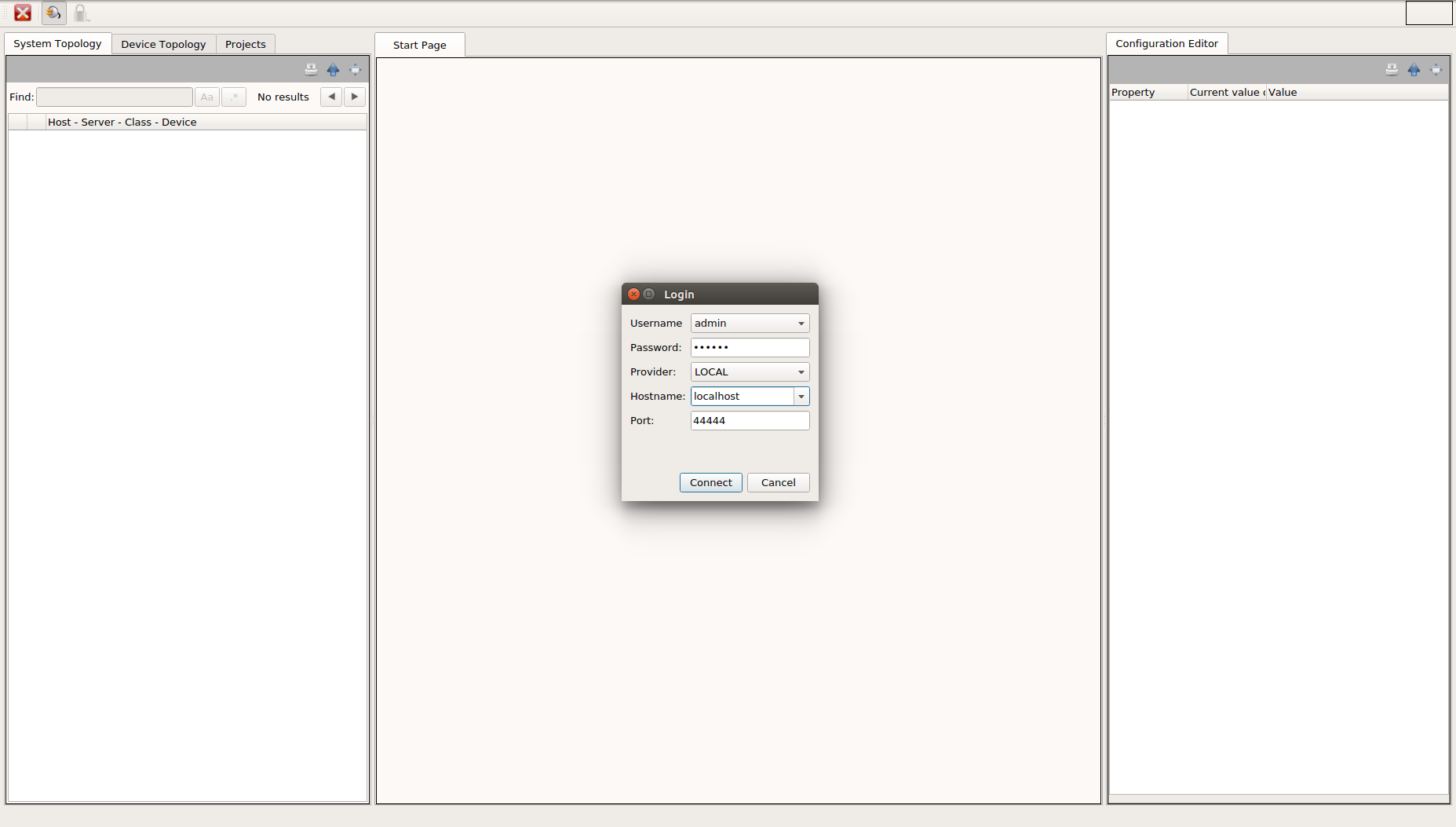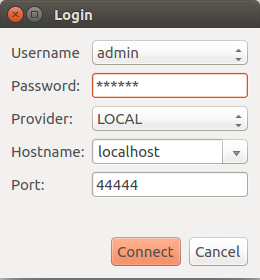The Karabo GUI¶
Getting Started¶
The GUI starts up into a non-connected state, meaning that you need to login to a specific GUI server with your login credentials. By doing so your access level is also determined and the appropriate options will be available to you.
karabo-gui
will open up this panel:

The karabo GUI application directly after startup¶
You can see that most of the panels are still empty, as you are in a non-connected state. From left to right the following panels are available:
The navigation panel, which gives you a live view of the full system topology and allows for filtering (
Left Area)The project panel, giving you a logical view on the projects you have loaded (
Left Area)The scene panel, which is used to display custom views (
Middle Area)The service panels, giving access to logging, alarm service and an
ikaraboconsole (Middle Area)The configurator panel, which lists all properties and slots available for a device as appropriate for your access level (
Right Area)
The connect dialog automatically shows up after starting the GUI application.
Alternatively, for connecting to a GUI server, the connect to server button can be clicked in
the top left of the application.
The connect dialog requires the operator credentials and the gui server
information (host and port) for connecting.
The GUI server selection field remembers the 5 last recently used gui servers configurations.

The GUI connection dialog.¶
After connecting to a GUI server, the GUI application will receive the Broker and Topology information showing a live view of the system.
Any of the listed panels may be detached and arranged separately on the screen. In the following each panel is introduced in more detail.
How to connect to the GUI Server¶
In order to use the Karabo GUI with the control network, we have to open an ssh tunnel towards the desired Karabo GUI server. This can be done as follows:
ssh desyusername@exflgateway -L LOCAL_FORWARDING_PORT:GUI_SERVER_ALIAS:GUI_SERVER_PORT
Hence, a tunnel forwarding from the GUI server of the XTD2/XTD9 installation looks like:
ssh desyusername@exflgateway -L 44444:sa1-br-sys-con-gui1:44444
Afterwards, launch the Karabo GUI on your local machine and connect to the GUI Server with the settings localhost and port 44444.
Sometimes it is even beneficial if you make the forwarding port differ from 44444 (e.g. 44445) if you have a local running GUI server already running on port 44444.
ssh desyusername@exflgateway -L 44445:sa1-br-sys-con-gui1:44444
In case the connection is refused, contact the responsible control network responsibles once you filled the control network access form.
If you want to connect a GUI from outside the DESY network, you have to tunnel twice, once through bastion.desy.de to get into the DESY network and then through exflgateway, e.g.
ssh -L38080:localhost:38081 desyusername@bastion.desy.de -t ssh -L38081:sa1-br-sys-con-gui1:44444 exflgateway
where 38080 is the local forwarding port and 38081 an intermediate port.
The Cinema¶
The Karabo GUI is capable to run in a cinema fashion, by just providing
a project database domain and the corresponding uuid of the scene:
karabo-cinema DOMAIN UUID
Since uuids are not convenient to handle, a key-stroke ctrl + c is available from the
project panel project_intro to copy the uuid to the selection clipboard.
The selection clipboard can be pasted with the middle mouse button.
The cinema can connect directly by providing host and port. Furthermore, multiple scenes can be launched and a username can be provided.
karabo-cinema DOMAIN UUID -host HOSTNAME -port PORTNUMBER -username USERNAME
karabo-cinema LOCAL 7f9023e8-bae3-4352-beb9-b0c162097b60 1d057710-2cc3-4410-a587-61ecb3c156c2 -host localhost -port 44444 -username expert
The Processing Lamp¶
A processing lamp is visible in the menu bar on the right side of the GUI on top of the configurator. It is used to visualize the difference between the arrival time of packet and its actual processing within the GUI client.

The processing lamp¶
Color |
status |
description |
|---|---|---|
Fine |
The Karabo GUI is up to date |
|
Warning |
The updates are at least behind by 2s |
|
Alarm |
The updates are at least behind by 5s |
The delay in processing only happens in very rare cases, e.g. Project loading. Without activity in the GUI, the processing lamp will not be able to change its color.
Note
The operator is still able to send out changes when the processing delay is large, e.g. stop the movement of motors!